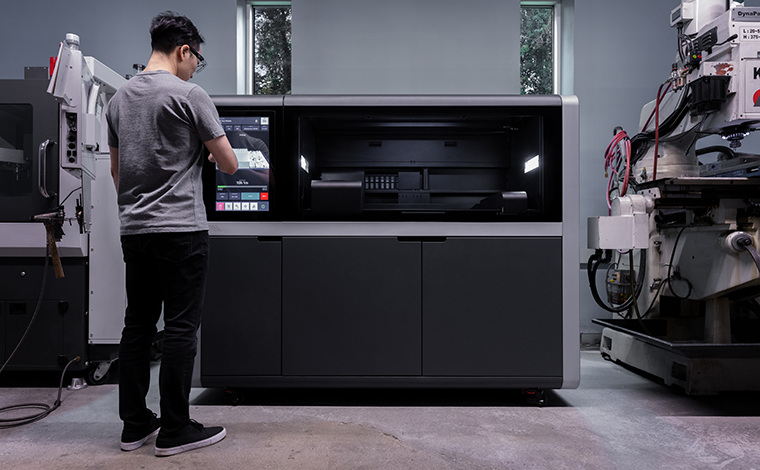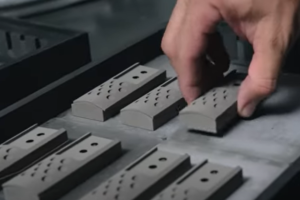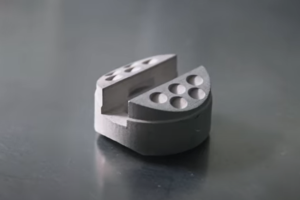
In our globalized society, making products half a world away from the point of need has become the norm. But the strategic risks with locating manufacturing capacity far away from consumers are increasingly exposed as complex global supply chains struggle to keep materials flowing into and products out of centralized industrial centers. A pandemic, extreme weather events, territorial invasions, and even ill-navigated container ships have clogged manufacturing arteries around the world and forced companies to reevaluate “just-in-time” production strategies.
Increasingly manufacturers are turning to 3D printing as a solution. AM 2.0 technologies like high-speed, high-capacity binder jet metal 3D printing or digital light processing of polymer resins bring the factory floor closer to consumers. Additive manufacturing enables fast product launches to match rapidly shifting consumer demands and helps reshape the supply chain in favor of locating inventory, or on-demand production capacity, closer to the end user.
Flexible, on-demand production
3D printers enable decentralized manufacturing by printing straight from CAD files without the need for traditional tooling or molds. While additive technologies are often used for rapid prototyping and fast iterations, 3D printing is increasingly used for production applications to get products to market fast. It is also gaining importance for on-demand spare parts, especially in sectors like oil and gas that value uptime as part of holistic view of parts replacement where the economic loss of downtime is crucial.
- PGV Industries, a manufacturer serving the oil and gas industry, uses 3D printing to produce parts like the ones shown above in far less time than it would take with traditional methods.
Doing more with less
In a tight labor market companies are forced to look for operational efficiencies that enable them to do more with less. 3D printing helps streamline production by eliminating process steps such as core assembly for castings or CNC machining setup subtractive metal production. Easy-to-adopt 3D printing technologies are enabling manufacturers to stay competitive offering fast turnarounds of complex designs to win new business with efficient technological offerings.
Digital parts inventory
Additive manufacturing technologies enable the production of complex parts while empowering users to convert physical to digital inventory. The digital workflow means tooling storage moves out of the warehouse and into the cloud.
 Combined with other advanced manufacturing techniques like 3D scanning, additive manufacturing enables on-demand production of legacy spare parts without traditional tooling and the long lead time and high investment costs that come with it. Companies are using 3D printing to quickly produce parts when and where they’re needed and shift the paradigm of what’s possible for replacement parts.
Combined with other advanced manufacturing techniques like 3D scanning, additive manufacturing enables on-demand production of legacy spare parts without traditional tooling and the long lead time and high investment costs that come with it. Companies are using 3D printing to quickly produce parts when and where they’re needed and shift the paradigm of what’s possible for replacement parts.
A more sustainable supply chain
More responsive production also makes for more sustainable production.
As companies consider the risk of how far critical components must travel, shortened supply chains enabled by additive manufacturing mean fewer trucks on the road and ships in the ocean, significantly reducing emissions and helping mitigate rising fuel prices from further affecting the supply chain. Emission-reduction is also aided by the design freedom of 3D printing that enables new, lightweight and space-saving designs.
Tooling-less manufacturing with 3D printing also makes short-run production economically viable, bringing manufacturing volumes more in-line with demand. This helps eliminate the waste of inflated production numbers used to justify the high cost of traditional tooling.
The next era of manufacturing

Supply chain disruptions are here to stay, and new advanced strategies are needed to survive and thrive in a tight labor market –3D printing offers digital manufacturing solutions
3D printing helps manufacturers create more resilient supply chains by enabling flexible, local, and tooling-less production. Companies looking to meet rapidly shifting demands and operate efficiently with less labor are finding a solution with 3D printing.
Looking for more solutions to your complex production challenges? Register for our upcoming webinar, to hear first-hand from manufacturers how your business can outperform the competition during the supply chain and labor crisis with 3D printing.
Subscribe to Our Email Newsletter
Stay up-to-date on all the latest news from the 3D printing industry and receive information and offers from third party vendors.
You May Also Like
3D Printing Unpeeled: Orbex Investment, IndoMIM and HP, Ultrasonic Waves
INDO-MIM has bought three HP Metal Jet S100 printers, operating two in India and one in Texas. This is a win for HP because the company has deep experience in...
3D Printing News Briefs, April 3, 2024: Kickstarter FDM 3D Printer, Artificial Eyes, & More
In 3D Printing News Briefs today, we’re talking about an FDM 3D printer on Kickstarter, advancements in artificial eye creation, and 3D printed solenoids for electromagnets. Then we’ll move on...
Firestorm Gets $12.5M from Lockheed and Others to Automate Drone Production with 3D Printing
Firestorm Labs is advancing an initiative that has been a topic of discussion on our site for a while: automating drone swarm production. Drones are increasingly altering the landscape of...
3D Printing Leaders Team with Rivelin for Robotic Metals Post-processing
UK-based Rivelin Robotics is working on creating a manufacturing cell to automate the post-processing of metal 3D printed parts. If successful, this approach could reduce the costs of metal 3D...
































